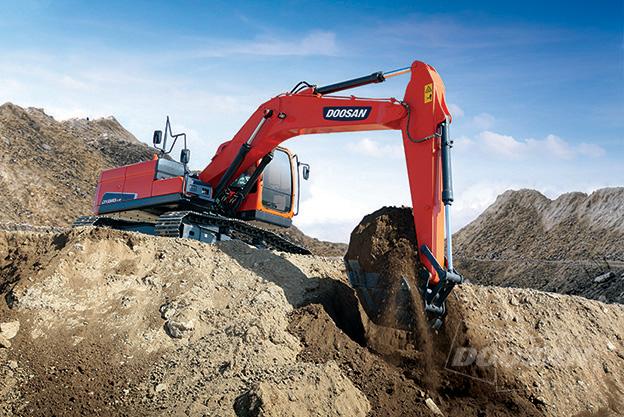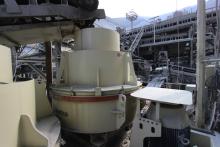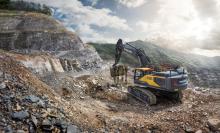
South Korea’s aggregates demand, fuelled by a buoyant construction sector, continues to look healthy. Guy Woodford reports.
South Korea and neighbouring North Korea have very much been in the international news headlines in recent months due to ongoing geopolitical tensions. On a more positive note, the historic meeting between Kim Jong-Un, North Korea’s leader, and Moon Jae-in, South Korea’s president, on 27 April has been widely hailed a success in moving the two Koreas’ relationship towards a friendlier footing.
What hasn’t been in the global news spotlight, but will be of great interest to major and ambitious smaller international aggregates producers, is the healthy state of South Korea’s aggregates and construction sectors.
Asia’s fourth largest economy, South Korea, has witnessed huge development of its commercial, residential and transport infrastructure. This has created significant demand for raw construction materials and construction and quarrying equipment. The country produces more than 330 million tonnes/year of aggregates to service its infrastructure needs.
South Korea’s highly competitive construction materials market is dominated by local players. An ongoing shortage of natural sand has led to suppliers increasingly focusing on producing quality manufactured sand. Meanwhile, the country’s latest generation of quarry professionals is increasingly investing in new crushing and screening plants and loading and hauling fleets, helping to lower their production cost per tonne.
Such quarry operators’ investment is justified given the wealth of major national infrastructure projects pencilled in for completion over the next few years. Following on from all the big infrastructure works linked to the successful staging of the PyeongChang 2018 Winter Olympics in February this year, are high-speed train projects, residential buildings projects, and airport expansions, all requiring huge volumes of aggregates and quarrying and construction equipment.
Due to the plethora of earmarked government and private company-controlled projects, South Korea’s construction GDP is forecast to grow to US$86 billion in 2018, compared to $70 billion in 2017, with construction GDP forecast to hit $91 billion in 2019.
Unsurprisingly, leading global business market research consultancies believe the South Korean construction sector success story will continue beyond next year. For example, Timetric’s Construction in South Korea – Key Trends and Opportunities to 2021 report states that the South Korean construction industry’s output value is expected to rise with a compound annual growth rate (CAGR) of 3.99% in the period 2017-2021.
The growth follows a 4.93% CAGR in the years 2012-2016, and will be driven, says Timetric, by the investments in public infrastructure, energy, commercial and industrial projects, and improvements in consumer and investor confidence. Moreover, a rise in building permits for the construction of residential and non-residential buildings in the country is expected to support the industry’s growth over the forecast period.
Timetric’s study states that the government’s focus on developing transport infrastructure, as well as efforts to boost energy production, particularly renewables, is expected to drive funding towards the construction industry over the forecast period. In June 2017, the government announced plans to invest KRW42 trillion (US$36.6 billion) on the renewable energy infrastructure, with an aim to eliminate coal power plants by 2020.
The report says huge government investment on the expansion of railway lines across the country aims to increase cross-country trade activities as well as provide a convenient transport system for the population. The government plans to spend KRW88.0 trillion (US$79.4bn) on increasing the railway network by 39%, going from 3,549.6km in 2016 to 4,934km by 2025. Such huge investment presents big commercial opportunities to national and international aggregates suppliers and world market quarrying and construction OEMs.
The Korean cement industry has been something of a lively scene over the last 12-18 months. In January 2018,
The Halla Cement deal is the latest in a number of key transactions to take place in the South Korean cement sector. Last year saw the acquisition of Daehan Cement by SsangYong Cement and
On 26 November 2017 in Eumseong, South Korea, Hyundai Construction Equipment (HCE), the South Korean global construction and quarrying market heavyweight, launched ‘Hyundai Construction Equipment Auction’, the first used construction equipment auction platform in Korea.
HCE says it sees used equipment auctions as a good way to increase its market share in emerging markets such as Southeast Asia. The OEM says it has the highest market share for new construction equipment in the emerging markets including Vietnam, Myanmar and Laos, with all those countries also having a high demand for used equipment.
The landmark first HCE Korean used construction equipment auction received an encouraging response from overseas customers, with around 100 mega-dealers and customers from major emerging markets including Vietnam, Hong Kong, Taiwan, Pakistan, Kenya and Chile participating in the event. Three HCE used equipment auctions are taking place in 2018 – with around 300 equipment models being auctioned off at each event.
Qiang X Zhang, Caterpillar territory manager for South Korea, said the South Korean government’s focus on welfare and the environment was leading to greater government funding for apartment building works and city maintenance, with all works needing to adhere to strict environmental regulations. However, latest figures show that aggregates demand is very much based on proximity to South Korea’s capital city, Seoul.
“In 2017, the aggregates demand for both Gyeonggi, the province around Seoul, and for Seoul itself, which is administered separately, was 82,358,000m³, a 14.8% increase on 2016. Excluding Seoul and Gyeonggi, national aggregates demand was 153,624,000m³, a 3.3% decrease on 2016.”
“In the Seoul area and the province of Gyeonggi new town construction is taking place, and this is where people come and find employment. The work taking place includes replacing old water pipes, laying underground communication cabling, and road maintenance.”
Zhang says granite and limestone are the most in-demand aggregates materials. Sea sand has historically also been in big demand, but environmental considerations have impacted extraction and driven aggregates suppliers to look for alternatives, including manufactured sand.
“Environmental concerns have a big influence on who gets aggregates supply contracts. The requirements to be granted or to extend the planning permission to quarry aggregates are very strict. Quarry companies are engaging with the surrounding population, employ local people and provide subsidies,” explains Zhang.
He continued: “Currently, the big aggregates companies are trying to increase their production capacity, to meet the demand generated by construction and road maintenance projects.”
Zhang said that customers were working with Caterpillar’s South Korean dealer, Haein, to become more efficient by selecting the best equipment for the job. This includes many taking part in a range of initiatives such as operator eco training and preventative maintenance programmes. Zhang said that some customers are considering automation technology as well as other ways to gain efficiencies on the operation of the job site.
Speaking about how he sees the South Korean aggregates sector in 10 years’ time, Zhang said: “It will remain stable unless a big event takes place, such as a possible football World Cup. Road maintenance [spending] is stable in South Korea. Apartment supply will decrease in line with the population level. Roughly, 70% of the aggregates and sand is used for social overhead capital [SOC] and house building.”
In February 2018, the company sold a total of 1,018 excavators in China. Doosan Infracore’s market share in February was 10.5%, up by 1.9% over the same month in 2017 and up by 3.2% over the previous month, marking Doosan Infracore’s highest market share in the six years since February 2012.
Furthermore, Doosan Infracore’s excavator sales in January and February jumped by 15.4% over the same period in 2017. The figure is almost double the company’s annual rate of global sales growth of 7.9%.
Notably, Doosan Infracore’s share of the market for mid-size excavators ranging from 20 to 24 tonnes reached 15.6% in February 2018 – said by the company to establish it as the market leader in China in this product size sector. The company has increased the sales proportion of its mid-size excavators - a high value-added product group - from 26% in 2017 to 47% in 2018, while continuing to expand its cash sales ratio.
Doosan Infracore attributes its quantitative and qualitative growth in China to its efforts to enhance its dealers’ competitiveness, launch customised products, and provide ‘DoosanCARE’ as a differentiated customer service.









